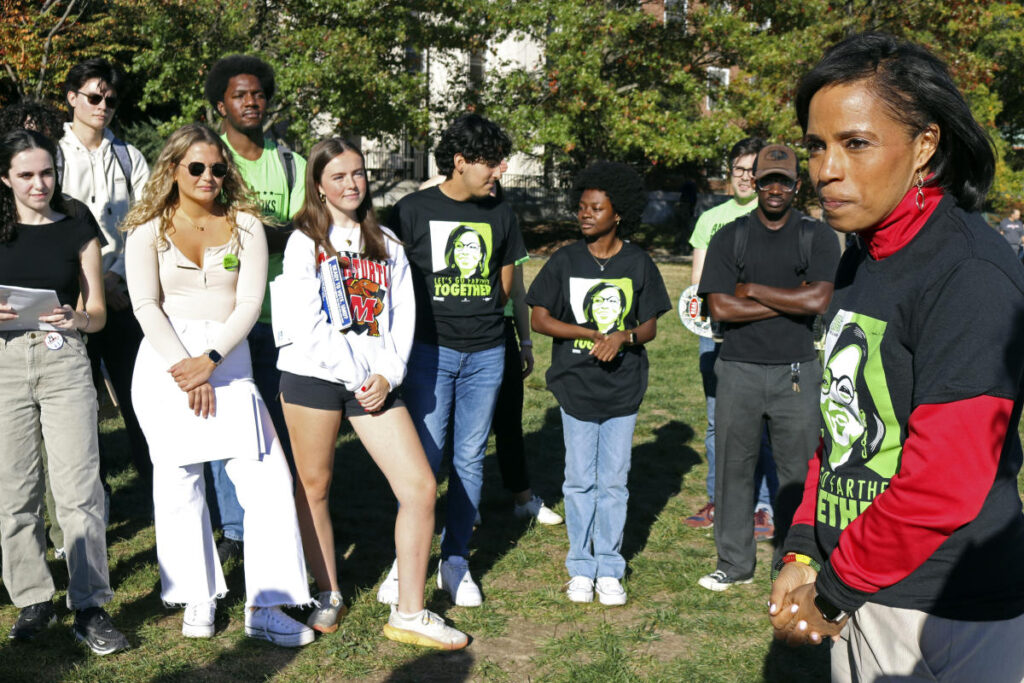The upcoming Senate race in Maryland is shaping up to be a critical contest, attracting interest from both Republican and Democratic voters in a state that leans heavily Democratic. Jon Michael, a Republican who describes himself as far-right, has expressed his ambivalence towards Governor Larry Hogan, who has been critical of Donald Trump yet remains a popular figure in Maryland politics. Despite his mixed feelings about Hogan’s past decisions, particularly his COVID-19 policies and his 2020 presidential vote, Michael believes Hogan is the best option for Maryland in the current election against Democrat Angela Alsobrooks. Michael’s sentiment reflects a broader tension among Republicans who are wrestling with their loyalty to Trump while recognizing the pragmatic choice of voting for Hogan to retain governance.
Conversely, Democrats are grappling with their nostalgia for Hogan’s past governorship while feeling an urgent need to protect their Senate majority. Some Democratic voters who previously supported Hogan for governor are now re-evaluating their positions ahead of the Senate race. Diane Stokes, a Democrat from Hyattsville, illustrates this shift by emphasizing the importance of unifying against the Republican Party to maintain a Senate majority that includes critical figures like Vice President Kamala Harris. The significance of the race is compounded by the national implications, especially given Maryland’s historical trend of Democratic dominance and the growing realization that Hogan could potentially upset the long-accepted balance.
As both parties intensify their campaigning efforts, the financial stakes of the race have soared, with each side spending over $35 million on advertisements and outreach, a substantial portion of which is sourced from outside donors. This level of investment underscores the intensity of the race and the pivotal role Maryland will play in determining the balance of power in the Senate, especially as Democrats defend a majority that hangs in a precarious balance nationally. Competing narratives are being formed, with Republicans showcasing Hogan’s track record while Democrats aim to galvanize support for Alsobrooks, who represents not just a political choice but a historic opportunity as the first Black woman senator from the state.
The grassroots responses to the upcoming election reflect a sense of urgency and significance from voters across the political spectrum. For many, like Paula Dickerson, the implications of this Senate race go beyond individual candidates and influence overarching policy directions and national governance. Even Democratic votes that swung towards Hogan in the past are being reconsidered against fears that a Republican victory could shift national policy away from Democratic priorities. Similarly, Republican voters like Liza Hamill express a motive for supporting Hogan not only based on his policies but also as a counter to the broader criticisms laid against the party by more progressive elements.
On the ground, the mobilization of younger voters and first-time activists signals the growing impact of grassroots efforts that are critical in shaping the race. Alsobrooks has tapped into a wellspring of enthusiasm among younger constituents and historically disenfranchised voters, focusing on representation and aligning her campaign rhetoric to reflect the diverse voices of Maryland. Campaign events at local educational institutions indicate a stronger engagement from students and younger demographics keen to contribute to the electoral process, marking a notable shift in participation levels compared to previous cycles.
Beyond party loyalties, the discourse surrounding this Senate race encapsulates a broader struggle over identity, representation, and political power in America today. Hogan’s campaign emphasizes a narrative of unity and independence, while Alsobrooks provides a counter-narrative that emphasizes empowerment and the need for consistent Democratic representation. As both campaigns push through early voting and into the final phases of the race, the outcomes will not only affect the immediate political landscape in Maryland but could resonate through the national conversation regarding partisan dynamics and the future of governance in the United States. This race embodies the larger stakes at play in contemporary American politics, where every vote holds potential repercussions that extend beyond state lines.

